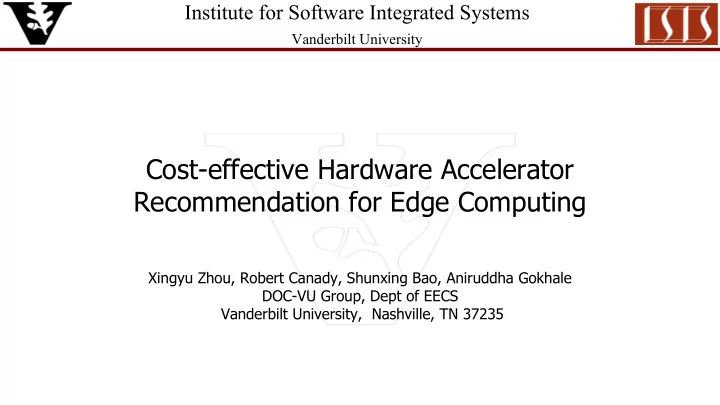

Institute for Software Integrated Systems Vanderbilt University Cost-effective Hardware Accelerator Recommendation for Edge Computing Xingyu Zhou, Robert Canady, Shunxing Bao, Aniruddha Gokhale DOC-VU Group, Dept of EECS Vanderbilt University, Nashville, TN 37235
Outline ▪ Current Edge HW Acc Status ▪ Challenge for HW Acc Deployment ▪ Solution Overview ▪ Case Study ▪ Conclusion
What are HW Accelerators? ▪ Accelerating computations ▪ For general or specific task settings CPU (most general) GPU (better suited for stream processing) FPGA (general in thoery but difficult to use) ASIC (specific)
Why Hardware Accelerators on Edge? ▪ Heterogeneous data sources from sensors; ▪ More compute intense processing requirements especially from image or video; ▪ Realistic physical constraints(power,size,cost. etc)
Challenge: which accelerator is best suited for application needs? ▪ Too many different hardware devices potential for edge + ▪ Current selection and evaluation research either single device or even low-level circuit design = ▪ Need to understand applicability of these accelerator technologies for at-scale, edge-based applications
Metrics for HW Acceleration Evaluation ▪ Latency => Application Response ▪ Power => Electricity Cost ▪ Commercial Cost => Market Price V. Sze, T.-J. Yang, Y.-H. Chen, J. Emer, "Efficient Processing of Deep Neural Networks: A Tutorial and Survey," Proceedings of the IEEE , vol. 105, no. 12, pp. 2295-2329, December 2017.
Overall Goal for HW Selection ▪ Define One HW Acceleration Strategy: (1) HW Acceleration Task Realization on Device (2) HW Acceleration Device Placement (location,time) ▪ Minimize deployment cost under constraints Current goal: minimize cost with design latency limit
Cost Evaluation Workflow Part I 1. Application design choose applications that can be accelerated ResNet50 (Classification) + TinyYolo (Detection) 2. Hardware configuration go through design flows
Cost Evaluation Workflow Part II 3. Per-Device Benchmarking record time and power consumption 4. Deployment Cost Approximation = devCost (hardware market price) + deployCost (for design topology and time cycle) 5. Choose device met requirements
Per-device Applicability Validation Applicability Test on Relative High Dimension Data: Object Classification tasks on a set of 500 images with a resolution of 640 ∗ 480. Vehicle Detection tasks on a road traffic video consisting of 874 frames with a resolution of 1280 ∗ 720.
At-Scale Approximatation Design Topology Potential Scenarios: 1. unmanned shopping using object classification 2. surveillance using detection Reliability-Driven System Deployment Goal: 1. should guarantee to handle no less than half (2 of 4) of input loads from every fog group (3 groups) with an overall confidence level of 99% 2. edge node inputs denoted by a normal distribution ( assumed identical for all nodes in this topology ) 3. edge node inputs with relatively high uncertainty level with stdFreq_in = muFreq_in ( inputCV=1.0 )
At-Scale Approximatation Bandwidth Setting: standard IEEE802 Wifi with 135Mbps
At-Scale Approximatation Settings: Increasing input strength for a 24-month deployment cycle 1. Why hardware accelerator necessary? CPUs: RaspPi@edge, FX6300@cloud worst 2. Power is critical for long-term two most cost-efficient options for edge: Ultra96 (FPGA) Jetson Nano (embedded GPU) 3. Device tradeoff: FPGAs hard to use,NCS not powerful
Summary & Limitations Presents a simple evaluation procedure as a recommendation system to help users select an accelerator hardware device for their applications deployed across the cloud to edge spectrum Cons: 1. A pure strategy of one single type of device is considered 2. One single type of acceleration task is set for all devices Plan to investigate at-scale deployment of RNN and GAN in edge scenarios; 3. Assume an ideal device task scheduling and device parallelism 4. Have not taken interference effects between device executions into consideration
Thank You! Q&A
Recommend
More recommend